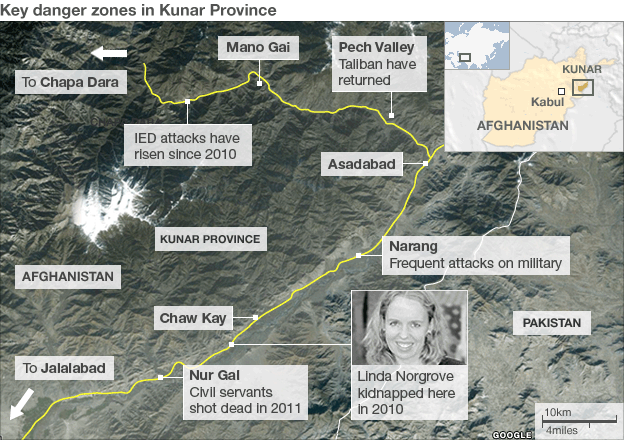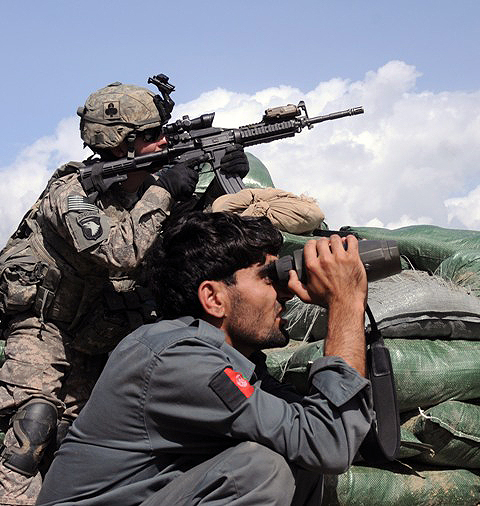Return To Nuristan – Only To Leave Again
BY Herschel SmithAn informative report from Reuters:
U.S. troops returned to the area in Afghanistan they call the “dark side of the moon” this week, a remote Hindu Kush region that controls several access routes to Kabul and where the coalition suffered one of its biggest reverses in the decade-long war.
This part of Nuristan province, in the mountainous far east of Afghanistan, could be the target of a planned Taliban offensive, coalition commanders say.
Carrying “speedballs” – black body bags packed with mortars, ammunition and heavy machine guns – a company of U.S. soldiers landed by helicopter on a narrow ridge and trudged up to a tiny Afghan army post overlooking icy peaks and plunging river valleys, as hostile as breathtaking.
With U.S. intelligence pointing to a possible attack by as many as 1,800 Taliban, the soldiers set up weapons over a backyard-sized square, while Afghan army soldiers in camouflage and plastic sandals pointed out fires and torchlight in the distance in the chill night air.
“We’ll get some eyes overhead to check it out. If it’s Taliban, we’ll get a plane up in the morning and drop a bomb on it,” said U.S. Major Jared Bordwell as some of his men from the 1-12 Infantry Regiment dropped down in the dust and tried to get some sleep.
American soldiers withdrew from Nuristan, or the “land of light”, after around 300 insurgents overran an isolated combat outpost near Kamdesh village – below where Bordwell’s men were huddled – on October 3, 2009, killing eight soldiers and wounding 22.
The former U.S. and NATO commander in Afghanistan, General Stanley McChrystal, decided in 2010 to give up remote combat outposts and shift American troops to protect larger population centers.
But it was through here that the Taliban shifted men and weapons for a suicide assault on Kabul’s diplomatic and government quarter in April, circling beyond the reach of U.S. and Afghan army positions to the south in neighboring Kunar province, coalition commanders say.
Stanley McChrystal managed the campaign for just over one year, what we should refer to as “the lost months.” During this time the Kunar and Nuristan provinces, and all along the Hindu Kush, were left to the Taliban and allied fighters to retrain, regroup, recruit, and raise support, while he played population-centric counterinsurgency in the cities. The attack on Kabul is minor and had little effect on the city. And that specific attack will be small compared to the effect these provinces will have on Afghanistan when the U.S. leaves. Another way of saying this is that the media using the Kabul attack as some sort of benchmark is both mistaken and frightening. It will get much worse. Continuing:
With Nuristan now a Taliban staging post and haven, the province is a vital pocket for U.S. forces based in Kunar, with only a few hundred Afghan soldiers and police over an area of 5,800 square km.
“Nuristan remains for me a challenge, a black hole. My line in the sand stops at the Kunar and Nuristan borders,” said Lt-Colonel Scott Green, a wiry former Ranger who oversees Nuristan.
But he will not be in the region for long – NATO troops are due to be withdrawn from north Kunar by October. Green and his men, who are based in Kunar and in Nuristan temporarily, will be among those withdrawn.
So his reduced-strength 1st battalion has to counter insurgents while simultaneously building Afghan capability and “retrograding” – closing up U.S. bases – all within months.
It is one of the most hostile areas in war-torn Afghanistan in a landscape that is equally hostile. Taliban and al Qaeda fighters pass through easily, from either Pakistan or from bases located out of easy NATO reach inside a 4 km-wide border buffer zone.
As many as 2,500 Taliban are thought to be in the province, controlling most districts, and around 300 are foreign, mostly Pakistanis or Chechens, Afghan commanders say.
The insurgents control what few roads there are and have three ways to move deeper into Afghanistan, through either the Kunar, Waygal or Parun valleys, which then wind down into provinces nearer to Kabul.
It is recognized that the surge was under-resourced. It is recognized that the Kunar and Nuristan Provinces are currently in trouble due to neglect. It is recognized that they may not survive as nominally Afghan-controlled provinces without U.S. troops. So U.S. troops are back – and plan to leave within about four months.
This is yet another sad tale of troops who know the value of the Hindu Kush, waning support for the campaign back home, and non-existent (or never-existent) support from the administration to properly prosecute this campaign.
Later in the report, an Afghan militia member shows up to inform them that the locals were very worried about the U.S. troop withdrawal. Of course they are. Command attempts to paint a happy face on the overall picture by saying that Kunar may in fact be okay.
Just a happy face couched in a sad report.





